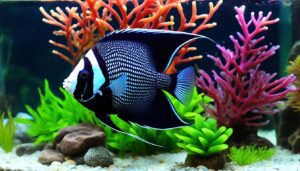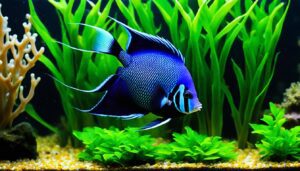Welcome to the exciting world of Marble Angelfish care. These fish are known for their elegant fins and beautiful patterns. They come from South America’s rivers. This guide will cover their lifespan, how to breed them, and the best tank setup.
These angelfish can live for 8 to 12 years with the right care. They need a clean, calm place to live. Choosing the right tank mates for your angelfish is crucial. They provide friendship and keep the tank balanced. Watching them grow from young fry to adults is amazing, and I’m here to help you learn how to breed and care for them.
To make your angelfish happy, recreate their natural habitat in your tank. They like warm water, between 78-86°F, and a pH of 6.0 to 8.0. A 29-gallon tank is good for up to four adults, but a 55-gallon tank is better for a group of young fish. Whether you’re experienced or new to fishkeeping, we’ll discover the joys of caring for Marble Angelfish together.
Introduction to Marble Angelfish
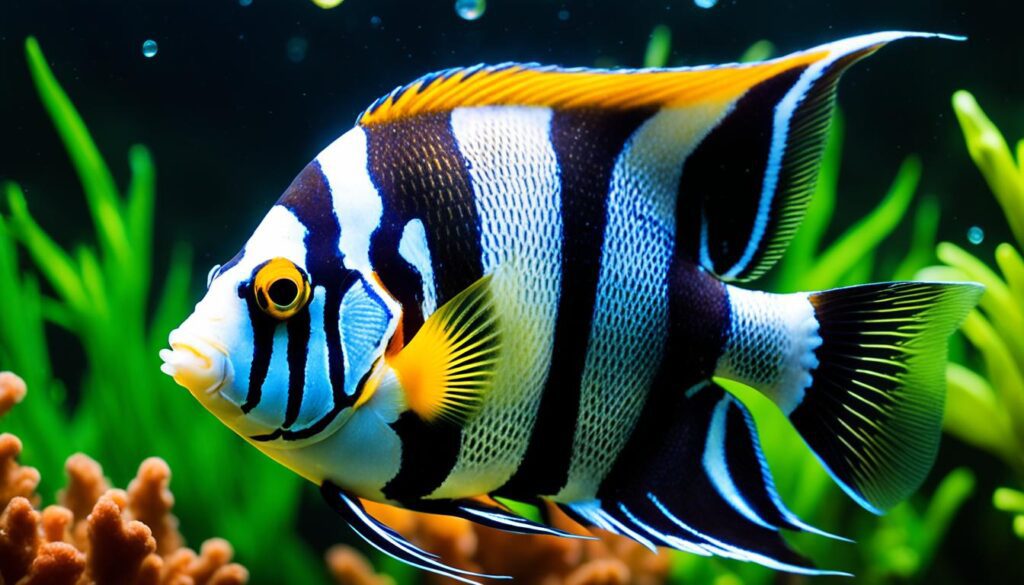
Marble Angelfish stand out with their marble-like patterns, captivating aquarium enthusiasts. They come from various Pterophyllum species, adding interest to the freshwater angelfish community. Their beauty, vibrant personality, and friendliness make them favorites for many.
There are many Marble Angelfish types, from silver and zebra patterns to unique koi designs. Each type adds something special to aquariums, suiting different tastes and making fish tanks look better.
They’re easy to care for, which is great for beginners and experts alike. But, they can be a bit feisty, especially when it’s breeding time. It’s best to keep them with peaceful fish like tetras and corydoras to maintain a calm tank.
Marble Angelfish do well in clean, stable water that is a bit acidic and warm, like in the tropics. A big enough tank is important for their swimming and for the places they need to breed properly.
- Care Level: Easy
- Temperament: Semi-Aggressive
- Live Plant Safe: Yes
- Diet: Omnivores – Includes high-quality flakes, pellets, and live foods such as saltwater shrimp and bloodworms
To make Marble Angelfish happy in a home aquarium, it’s important to get their care, surroundings, and tank mates right. With proper attention, Marble Angelfish will add beauty and life to any aquarium.
Understanding the Size and Growth of Marble Angelfish
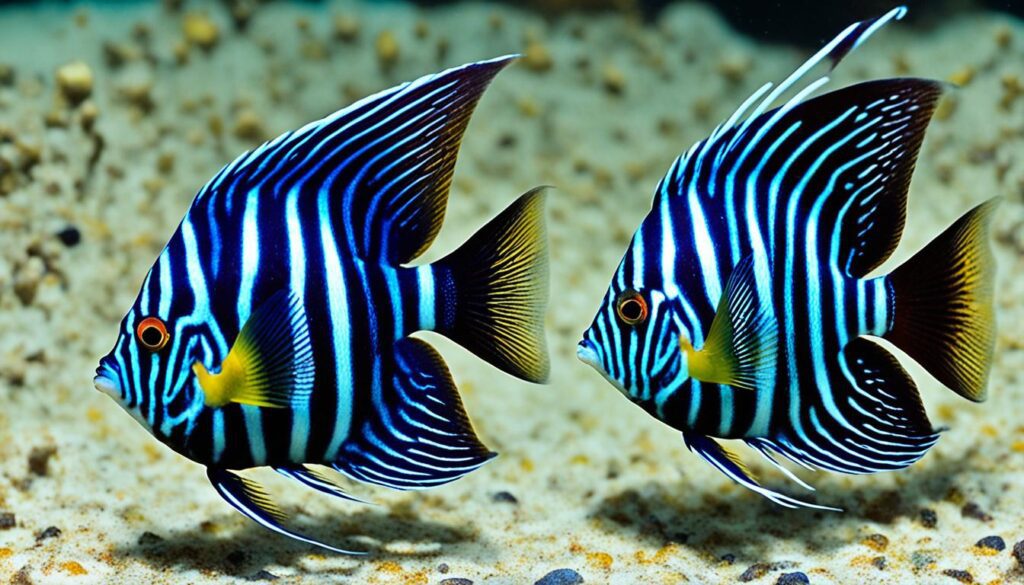
Starting with Marble Angelfish requires knowing their growth and development. This knowledge helps you create the perfect home for these beautiful fish.
Typical Size Range for Adults
The usual size for an adult Marble Angelfish is 6 inches long. With fins, they can reach up to 8 inches tall. If you prefer bigger fish, look into the Altum Angelfish. They can grow up to 7 inches long and 10-13 inches tall.
The Growth Process from Fry to Full Adulthood
The growth journey of an Angelfish is fascinating. Raising them right means having warm water and giving them nutritious food.
Stage |
Size at Start |
Diet |
Expected Growth |
|---|---|---|---|
Fry |
1-2 cm |
Live baby brine shrimp, Hikari First Bites |
Quick growth in first months |
Juvenile |
2-4 cm |
Krill flakes, frozen bloodworms |
Steady growth up to 8 months |
Adult |
5-6 inches |
Varied diet, high in protein |
Slower, stabilizing growth |
Watching fry grow from the size of a U.S. nickel is rewarding. A bigger tank and careful breeding can help your fish thrive.
Learn how to care for angelfish and get the most from your tank with this in-depth angelfish care guide.
Marble Angelfish: Tracking Their Lifespan
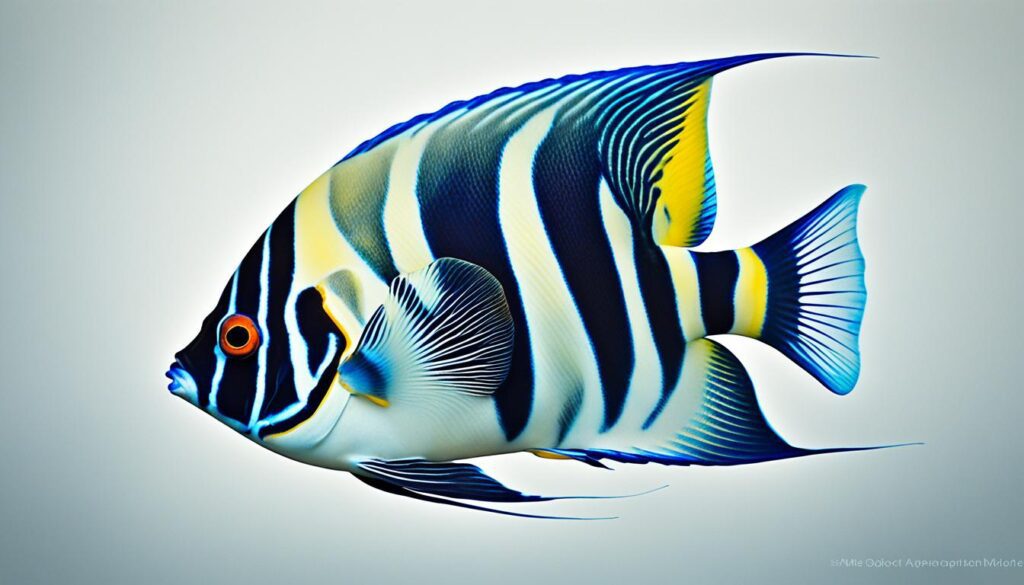
Knowing how long Marble Angelfish live is key for aquarium lovers. They live for 8 to 12 years with the right care. The lifespan of these fish can greatly change due to some factors we can control.
Good care is vital for them to live longer. This means clean water, a varied diet, and no stress in their home. Let’s dig into what helps them live a long and happy life.
Factors Influencing Lifespan
Care and attention are crucial for Marble Angelfish to thrive. Let’s see what matters most:
- Clean Water: Changing water often is a must to keep toxins away.
- Quality Diet: They need good food, like high-quality flake foods and some live or frozen treats.
- Stress Reduction: A calm tank without too many fish or bullies keeps them happy.
A controlled environment boosts their aquarium lifespan. Here’s what Marble Angelfish need to do well:
Condition |
Requirement |
|---|---|
Tank Size |
Minimum 20 gallons |
Temperature |
75-82°F (24-28°C) |
Water pH |
6.0 to 8.0 |
Diet |
High-quality flake or pellet, with live/frozen feeds |
Following these tips and giving angelfish care can help them live a long, healthy life. They can enjoy their days fully with our help.
Creating the Perfect Habitat: Tank Setup for Marble Angelfish
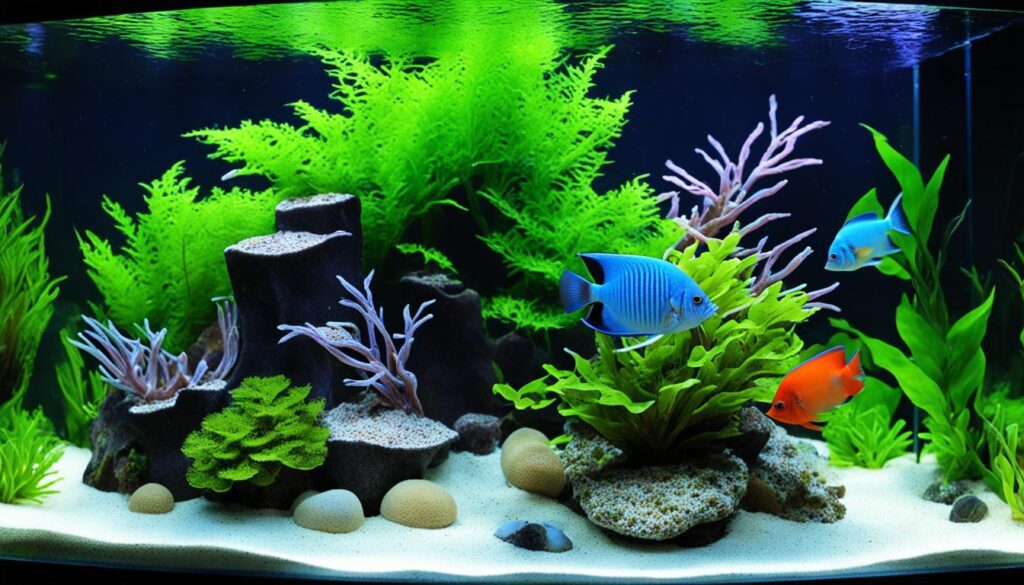
As an experienced aquarist, you know the right environment is key for Marble Angelfish. Picking the correct angelfish tank size is crucial. They need space to be happy, so a tank that holds at least 55 gallons is best.
It’s crucial to match the water to their native South American rivers. The perfect angelfish water conditions are warm, between 75 to 84 degrees Fahrenheit. The pH level should be kept between 6 and 8. This keeps them healthy and their colors bright.
Aquarium plants make the tank look good and feel like home for the fish. Java Fern and Anubias are great. They provide cover and help keep the fish stress-free. Plus, these aquarium plants clean the water by taking in nitrates and releasing oxygen.
Keeping the tank clean is essential. I suggest changing 10-25% of the water each month. This keeps the home of the angelfish fresh. Using a good filter helps remove bad stuff and keep the water clear, according to experts at FantaSEA Aquariums.
Setting up the ideal tank for your angelfish takes focus. You need to know what they need and make constant tweaks. Get the tank size, water, and plants right, and your Marble Angelfish will not just live but flourish.
The Essentials of Angelfish Care and Health
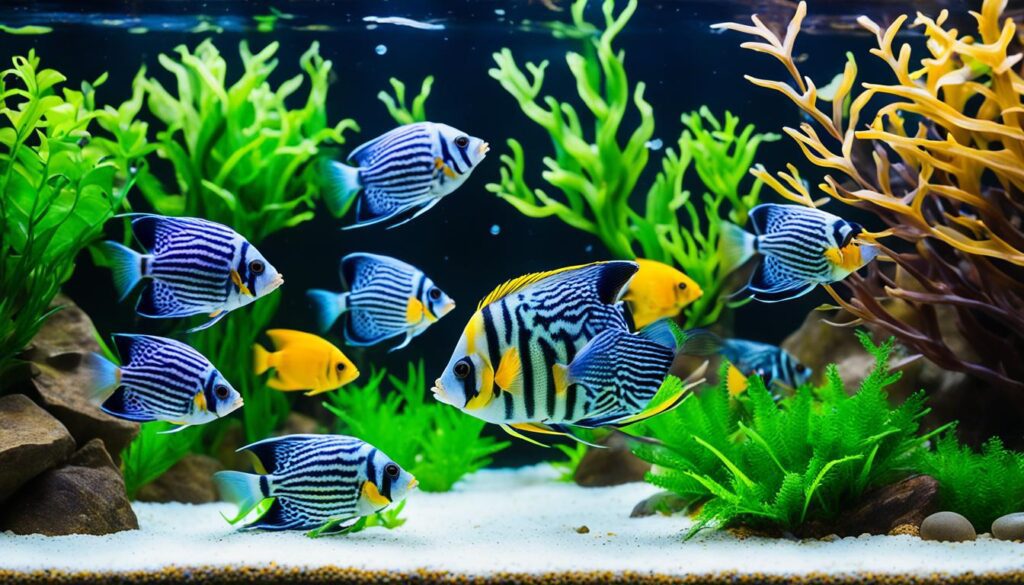
Keeping Marble Angelfish healthy in a tank needs careful work. You must watch their diet and where they live. Let’s delve into the diet and surroundings that keep these lovely fish thriving.
Dietary Preferences and Nutrition
Angelfish health starts with what they eat. Their diet should be varied and high in quality. Marble Angelfish feeding should include top-notch pellets and flakes. Sometimes, give them live or frozen treats like bloodworms, especially before they breed. For baby fish, tiny live brine shrimp are perfect. They help the young grow strong, slowly moving to good quality prepared food.
- Floating or sinking pellets: Daily diet base
- Freeze-dried bloodworms and tubifex worms: Weekly treats
- Frozen bloodworms: For breeding preparation
- Live baby brine shrimp: For fry
- Hikari First Bites: For growing juveniles
Maintaining Water Quality and Parameters
Good angelfish water quality is key. These fish like their water warm, from 78-86°F, with a pH of 6.0 to 8.0. Changing water often and keeping an eye on it helps stop diseases and keeps fish happy.
Parameter |
Optimal Range |
|---|---|
Temperature |
78-86°F |
pH Level |
6.0-8.0 |
Water Hardness |
Adaptable to various conditions |
Test the water often and change it to keep it clean. This, plus good food, makes a great life for your angelfish. They can live healthy for 8 to 12 years in such conditions.
Marble Angelfish Angelfish
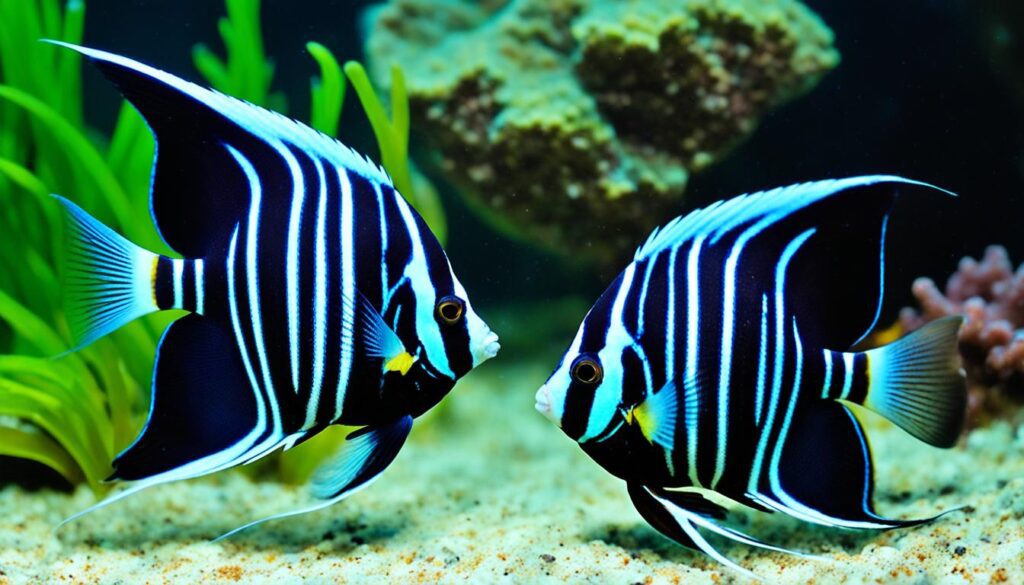
When looking for new fish, I always go for healthy angelfish first. I check how active they are and if they eat well. Choosing fish with these angelfish characteristics means your tank will be full of energy.
Identifying Healthy Specimens for Your Tank
I prefer young fish, about the size of a quarter. They’re usually healthier. A chunky body and a big head mean they’re strong and ready for angelfish breeding.
Breeding Practices and Recognizing Mating Behavior
Breeding Marble Angelfish takes time and careful observation. They’re ready to breed at 6 to 12 months old. Make sure they have a separate tank with a place for laying eggs. When they start cleaning a spot, it means eggs are coming soon.
Starting them off in a group helps them find a mate naturally. Once they pair up, moving them to a special tank helps. This makes breeding easier to watch and more successful.
Here’s a quick guide to important breeding conditions and genetics from my experience and other breeders:
Condition |
Ideal Range |
|---|---|
Water pH Level |
6.5 – for optimal breeding conditions |
Water Temperature |
80ºF – 85ºF – encourages spawning |
Genetic Diversity |
Various – influences pigmentation and overall health |
Knowing about angelfish breeding, mating behavior, and genetics is key for Marble Angelfish breeding success. It’s a rewarding process that lets you see life unfold in your aquarium.
Companionship in the Aquarium: Tank Mates for Marble Angelfish
Having the right friends in an angelfish tank is very important. Marble Angelfish look beautiful with their long fins and unique patterns. They can grow up to 6 inches and need the right tank mates. A well-balanced tank is about more than looks. It’s about making sure everyone can live together happily. Marble Angelfish like their water between 78 and 84°F. They also prefer a pH level of 6.5 to 7.8.
Choosing tank mates is about more than just size. You also have to think about how they act. For example, Corydoras Catfish are peaceful and need at least 15 gallons of space. Platies and Mollies also get along well with angelfish. They do best in tanks that hold 20 to 30 gallons. They all enjoy warm water. This helps create a calm tank without any fish that may pick on others.
Kribensis and Bristlenose Plecos are great companions for Marble Angelfish in larger tanks. They all need space, so make sure your tank is at least 30 gallons. Smaller fish like Otocinclus Catfish are perfect for smaller tanks. They only need 10 gallons. Colorful fish like Ram Cichlids and Praecox Rainbow Fish need 15 to 40 gallons. They add beauty without causing trouble. The secret is knowing what each fish needs and making sure they’re a good match.

